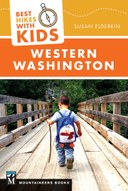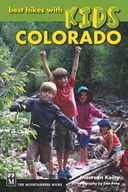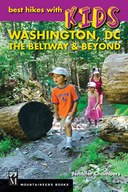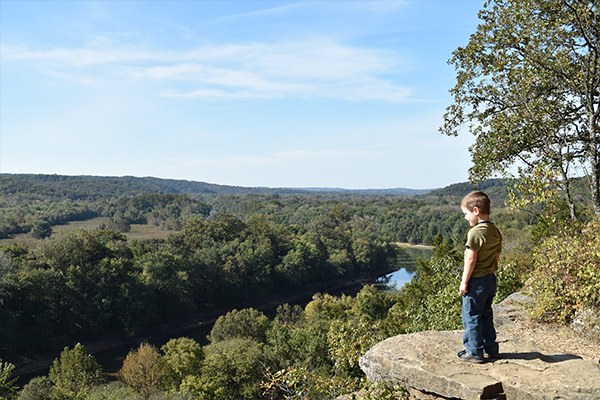
Kathy Schrenk is the author of Best Hikes with Kids: St. Louis and Beyond, one in a series of regional family hiking guides that Mountaineers Books offers. Kathy is committed to building a love of nature in her children by taking them onto trails and showing them how much fun the outdoors can be. Following are tips to keep these outings fun that have worked with Kathy's kids.
What ages are your kids and when did you start hiking with them?
My kids are currently 13, 12, and 6. Each of them was "hiking" - riding in a carrier—since before their first birthday. I was back on the trail as soon as the doctor would allow after giving birth—mostly for my own sanity. When they started toddling, we kept hiking, letting them walk until they were tired, and then carrying them. Then came the hardest phase: when the kids are too heavy to be carried but still too little to hike, usually some time between ages 2 and 4. That's when you have to adjust your expectations and let yourself be satisfied with slow, short hikes. Remember that it will eventually be worth it when your kids have great memories of hiking from throughout their childhood.
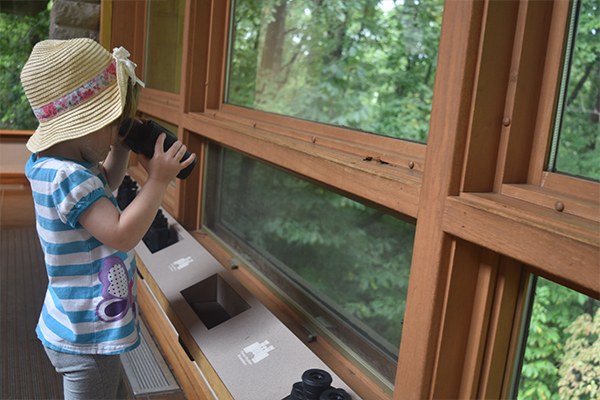
what hikes do you find optimal for your kids?
Every kid is so different; my 13-year-old loves hikes up to 10 miles a day but my 12-year-old complains about anything more than three miles. For strong, enthusiastic hikers like my oldest child, the [St Louis area's] Mina Sauk Falls trail at Taum Sauk State Park is great, especially if you add the bonus miles to Devil's Tollgate – for a total of about five miles. For littler kids, there are tons of great options, like Bootleggers Trail in Creve Coeur County Park, the White Bison loop in Lone Elk County Park, and either of the loops at Don Robinson. There’s such a wide variety of trails in the St. Louis area that it’s easy to find a hike of just about any length, from one-and-a-half miles for the littlest to four or more miles for older kids.
What games or distractions do you use on the trail to keep your kids having fun (and avoid whining)?
The best distraction is a buddy. When kids have other kids with them—even if they don't know them, or even if they aren't very close in age—the hike is automatically more fun. If there’s no one around to hike I like to bring candy and snacks that they only get when they're on hikes—"I'll give you a chocolate chip if you get up the next hill!" Some kids will keep busy for miles with a cheap digital camera. Researching the features of the trail before you reach the trail head can also help. If you can tell your kid, “I read that there’s a neat waterfall toward the end of this loop,” or “The online reviews say people often see turtles here,” kids are more likely to keep a good attitude and stay interested in walking forward on the trail.
What food and hydration do you pack for your kids or have them carry in their packs?
Always pack more snacks and water than you think you’ll need. If you’re hiking with more than one child, as soon as one wants a snack, the rest are pretty much guaranteed to want snacks. This is a good practice to get in the habit of no matter how many kids you’re hiking with, because accidents happen and you never know when you might take a wrong turn and end up out in the woods longer than you planned. Nuts, dried fruit, kids-sized granola bars, and small amounts of candy are all good items to keep in your backpack. Everyone should have at least 16 ounces of water to keep hydrated and happy on the trail. I also keep a Life Straw in my pack, even for day hikes. It’s a simple water filter that weighs almost nothing and costs about $25. It’s a great insurance policy in case you spill all your water or leave your bottle on a rock during a break. Few things will ruin a hike as fast as dehydration, especially in hot, humid Missouri.
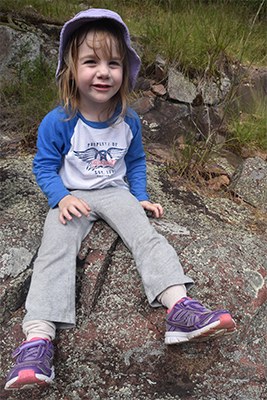
How about footwear, clothing and gear? Is family hiking expensive in this regard?
Hiking doesn't have to cost more than the price of transportation to the trailhead. Kids and adults can hike in sneakers. Most people have a backpack, a water bottle, and the contents of a basic first aid kit. Check The Mountaineers web site for the Ten Essentials (map, sun protection, and bug spray are a few). Aside from that the only gear you need are comfortable shoes and clothes.
On vacations where you expect to hike, does your family camp or do you stay in lodging and go on hikes from there?
We do a little of both. You certainly don’t have to be an avid camper to sleep close to nature. Many Missouri State Parks have cabins for rent that cost much less than a hotel and are often steps from a trailhead.
Why did you want your kids to experience outdoor recreation? What do you hope they’ll get from it?
I grew up in the Chicago area—not an outdoorsy place to begin with—in one of the least outdoorsy families around. The first time a friend took me car camping in the redwoods of the San Francisco Bay Area, I felt like I had come home. It was a revelation. Waking up under the canopy of the branches hundreds of feet high made my heart soar. Several years later I was a mom and I knew I wanted to get my kids outside as much as possible. My desire to get my kids interested in outdoor activities was partly selfish—I didn’t want to stop adventuring just because I’d had kids. But I also wanted them to experience the joy I felt when I was outside walking through a forest or wildflower-filled glade.

Each of the Best Hikes with Kids books is written by an experienced hiker mom and includes tips for keeping children engaged and having fun in the outdoors. Kathy's edition is Best Hikes with Kids: St. Louis and Beyond. Also see the Adventuring with Kids series of family-vacation guides to national parks.
 Mountaineers Books
Mountaineers Books
